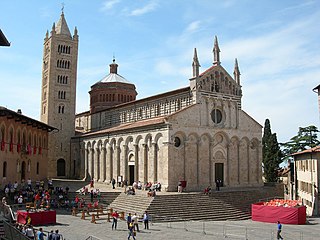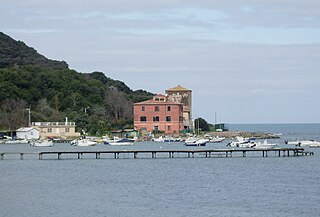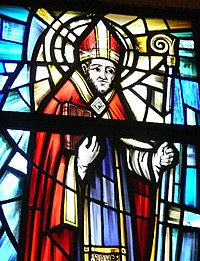Traditions and legends
An alternate tradition made him a bishop of Massa Marittima around 544 AD, and devotion to the saint in this city arose after Massa Marittima became an episcopal center. [2]
Another tradition states that Cerbonius was a native of North Africa who was the son of Christian parents. He was ordained a priest by Regulus (Regolo), though not the same one as in the Scottish legend. Due to persecution by the Arian Vandals in North Africa, the local Christian community dispersed, and together with Regulus, Felix, and some priests, Cerbonius escaped to Italy. [3] After a storm at sea, they landed at Tuscany, where they lived as hermits. During the war raging currently in Italy between Byzantine and Gothic forces, Regulus was imprisoned and decapitated by the Goths after being accused of aiding the Byzantines. [2]
After the death of the bishop of Populonia, Florentius (Fiorenzo), the citizens and clerics asked that Cerbonius serve as their bishop. The citizens soon became frustrated with him, however, since Cerbonius rose every Sunday at daybreak and said mass instead of doing so at the normal hour. The people complained to Pope Vigilius. Vigilius, on hearing what Cerbonius had done, became angry and sent legates to Piombino to bring the bishop to Rome. They found Cerbonius eating breakfast and accused him of heresy, believing that he was eating before performing mass, when in fact he had already performed the service.
They brought him back to Rome. During the way, he cured three men suffering from fever and tamed some wild geese by making the sign of the cross over them, which explains this particular attribute. The geese accompanied him to St. Peter's and flew off after Cerbonius made the sign of the cross over them again. [2]
At Rome, the next morning at daybreak, Cerbonius went into the Pope's chamber and roused him out of bed. He then asked the Pope if he did not hear angels singing; Vigilius replied that he did hear anything of the kind. Cerbonius went off to say mass and Vigilius gave him leave to say his mass at any hour of the morning that pleased him, and sent him back to Piombino. [4]
Encounter with Totila
For hiding several Roman soldiers, he was ordered to be killed by a wild bear by Totila, king of the Ostrogoths, during Totila's invasion of Tuscany. However, the bear remained petrified before Cerbonius. It stood on two legs and opened its jaws wide. Then, it fell back on its paws and licked the feet of Cerbonius. Totila exiled Cerbonius instead, to the island of Elba. [3]
Around 575 AD, now old and sick, Cerbonius begged to be buried in Populonia. He asked, however, that those burying him should return immediately to Elba. His friends obeyed him. The ship carrying his body ran into a heavy storm, but arrived safely at Populonia. Cerbonius was buried and his followers returned quickly to Elba. Soon after, the Lombards seized Populonia; Cerbonius had foreseen this and had saved his friends.
The 540s decade ran from January 1, 540, to December 31, 549.

Year 546 (DXLVI) was a common year starting on Monday of the Julian calendar. The denomination 546 for this year has been used since the early medieval period, when the Anno Domini calendar era became the prevalent method in Europe for naming years.
Pope Pelagius I was the bishop of Rome from 556 to his death. A former apocrisiarius to Constantinople, Pelagius I was elected pope as the candidate of Emperor Justinian I, a designation not well received in the Western Church. Before his papacy, he opposed Justinian's efforts to condemn the "Three Chapters" in order to reconcile theological factions within the Church, but later adopted Justinian's position.

Piombino is an Italian town and comune of about 35,000 inhabitants in the province of Livorno (Tuscany). It lies on the border between the Ligurian Sea and the Tyrrhenian Sea, in front of Elba Island and at the northern side of Maremma.

Maria Anna Elisa Bonaparte Baciocchi Levoy, better known as Elisa Bonaparte, was an imperial French princess and sister of Napoleon Bonaparte. She was Princess of Lucca and Piombino (1805-1814), Grand Duchess of Tuscany (1809-1814) and Countess of Compignano by appointment of her brother.
Saint Regulus or Saint Rule was a legendary 4th century monk or bishop of Patras, Greece who in AD 345 is said to have fled to Scotland with the bones of Saint Andrew, and deposited them at St Andrews. His feast day in the Aberdeen Breviary is 17 October.

Massa Marittima is a town and comune of the province of Grosseto, southern Tuscany, Italy, 49 km NNW of Grosseto.

Populonia or Populonia Alta today is a frazione of the comune of Piombino. As of 2009 its population was 17. It is one of I Borghi più belli d'Italia. Populonia is especially noteworthy for its Etruscan remains, including one of the main necropolis in Italy, discovered by Isidoro Falchi.

The Lordship of Piombino, and after 1594 the Principality of Piombino, was a small state on the Italian peninsula centered on the town of Piombino and including part of the island of Elba. A vassal of the Kingdom of Naples associated with the State of the Presidios and a territory of the Holy Roman Empire formed from the remnants of the Republic of Pisa, it existed from 1399 to 1805, when it was merged into the Principality of Lucca and Piombino. In 1815 it was absorbed into the Grand Duchy of Tuscany.

Massa Marittima Cathedral is a Roman Catholic cathedral in Massa Marittima, Tuscany, Italy, dedicated to Saint Cerbonius. Formerly the episcopal seat of the Diocese of Massa Marittima, it is now that of the Diocese of Massa Marittima-Piombino.

Angelo Comastri is an Italian prelate of the Catholic Church. He was Archpriest of St. Peter's Basilica from 2006 to 2021, and Vicar General for the Vatican City State and President of the Fabric of Saint Peter from 2005 to 2021. He previously served as Bishop of Massa Marittima-Piombino (1990–1994) and Territorial Prelate of Loreto (1996–2005). He was named a cardinal in 2007.

The Diocese of Massa Marittima-Piombino is a Latin Church diocese of the Catholic Church in Tuscany, central Italy. It was known as Diocese of Massa Marittima before 1978. Up until 1458, it was a suffragan of the archdiocese of Pisa; since 1458, it has been a suffragan of the Archdiocese of Siena. The territory of the diocese includes the islands of Elba and Pianosa, and Capraia.
The 215th Coastal Division was an infantry division of the Royal Italian Army during World War II. Royal Italian Army coastal divisions were second line divisions formed with reservists and equipped with second rate materiel. They were often commanded by officers called out of retirement.

Baratti is a village frazione of the comune of Piombino in the Province of Livorno, with roughly only 15 residents.

Vigilius of Trent is venerated as the patron saint and bishop of Trent. He should not be confused with the pope of the same name.

Massa Cathedral is a Roman Catholic cathedral in Massa, Tuscany, central Italy. It is dedicated to Saint Cerbonius. Formerly a conventual church, it was declared the episcopal seat of the Diocese of Massa Carrara at its creation in 1822, and is now the seat of the bishop of Massa Carrara-Pontremoli.
Alessandro Petrucci was a Roman Catholic prelate who served as Archbishop of Siena (1615–1628) and Bishop of Massa Marittima (1602–1615).
Ventura Benassai was a Roman Catholic prelate who served as Bishop of Massa Marittima (1501–1511).
Giovanni Battista Malaspina (1589–1655) was a Roman Catholic prelate who served as Bishop of Massa Marittima (1629–1655).

The Republic of Massa was a small Italian state located in Central Italy that existed from 1225 to 1336. It was founded in today's city of Massa Marittima and expanded to cover an area corresponding to the current upper Maremma.
This page is based on this
Wikipedia article Text is available under the
CC BY-SA 4.0 license; additional terms may apply.
Images, videos and audio are available under their respective licenses.













